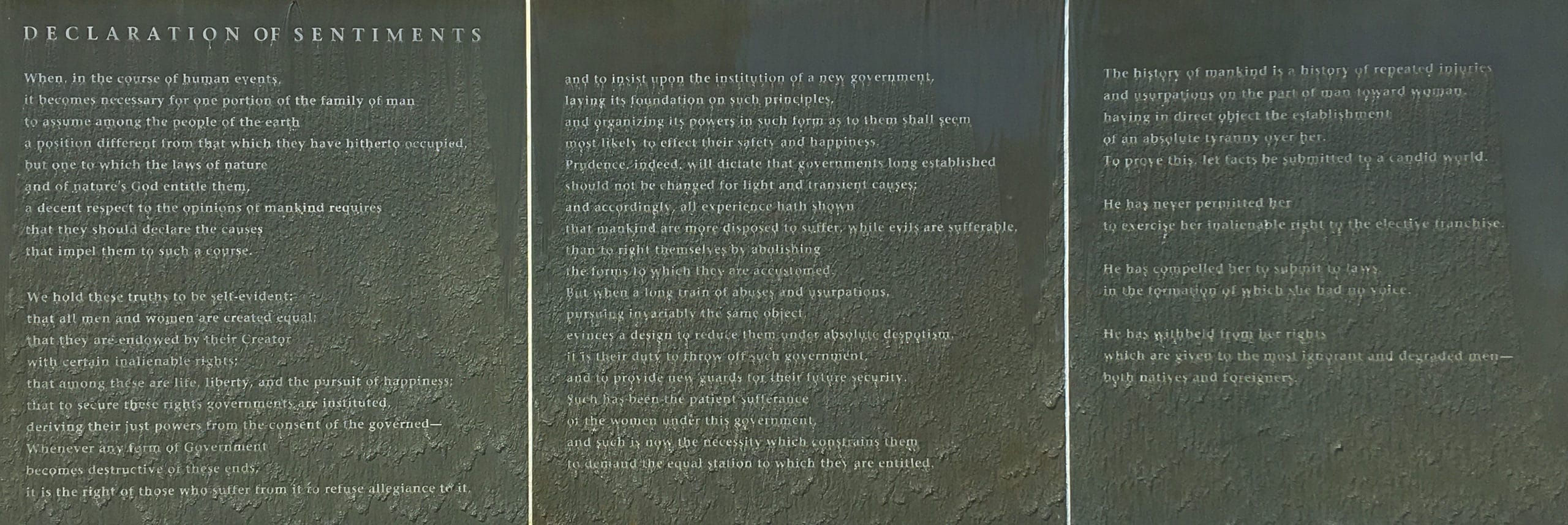
We hold these truths to be self-evident; that all men and women are created equal; that they are endowed by their Creator with certain inalienable rights; that among these are life, liberty, and the pursuit of happiness; that to secure these rights governments are instituted, deriving their just powers from the consent of the governed.
––The Declaration of Sentiments, July 1848
The nation has just celebrated the 100th anniversary of the ratification of the 19th Amendment, which gave women the right to vote. The Declaration of Sentiments articulated the circumstances and aspirations of many women in mid-19th century America – many, but perhaps not even a majority, as cultural norms weighed heavily against any efforts to make progress on the issue.
Nevertheless, over time those words, echoing the Declaration of Independence, displaced and eventually replaced our common understanding of the original declaration.
All men AND women are created equal. That most certainly was not what Thomas Jefferson and the other signers of the Declaration of Independence had in mind in 1776. At that time, and 11 years later when they sought to define how they would govern themselves, only all MEN were created equal, and only all men who OWNED PROPERTY, at that.
When Elizabeth Cady Stanton and her fellow signers of the Declaration of Sentiments added “and women” to that statement of equality, their radical (for the time) thinking may have included women of color. Though when push came to shove, political expediency would have them settle for less than universal suffrage. Some were grateful when black men achieved the right to vote under the 15th Amendment, while many would have been satisfied if only white women had been granted the vote.
Today, when it comes to gender, race, religion, or other defining characteristics of human individuality or culture, we emphasize the universal in the words “ALL men and women”. We apply this phrase broadly to include the full melting pot of American society, including extending the inherent rights and liberties beyond the literal meaning of the phrase to encompass gender neutral or non-binary people as well. At the same time, we also know that we still have some way to go before equal rights, including voting rights, are fully secured for all.
As we’ve noted when discussing the growth of government, the United States is adept at remaking itself and tweaking its operating design to reflect changing circumstances. When it comes to the slow but inexorable expansion of voting rights, the language of the Declaration of Sentiments is the upgrade to the Declaration of Independence that has powered the heart and soul of the civil rights movement for all people in our country.
Still, our faith in the aspirations of those words sometimes blinds us to the reality on the ground. Despite the legislative gains in the last half of the last century, there are those who would still seek to limit the voting rights of many eligible citizens. After a golden era for civil rights in the US that stretched from the early 1960s to the late ’90s, anti-democratic sentiments again seeped into our electoral system as attempts at vote manipulation and voter suppression increased, and became increasingly more successful even as they remained under the radar for most Americans. But no longer are these efforts invisible.
The Republican Party, which has been increasingly dominated by far right extremists and supporters of QAnon–a group that the FBI has labeled a domestic terrorist threat–has for the last twenty years persistently attacked voting rights on multiple fronts. And as has been widely reported, the President of the United States is openly seeking to undermine the election even as he granted a pardon to Susan B. Anthony for the crime of voting as a woman in 1872 – a pardon that Anthony never would have wanted. While sweeping generalizations of historic precedent are often easily disproved, I’ll take the risk: Never before in this country have we experienced such blatant disregard and disrespect for the laws and the Constitution by people in the White House.
Our system of government has survived other crises, and those in leadership have in the past moved swiftly to change the system to make sure such crises don’t arise again in quite the same way. The frustrating but empowering truth of democracy is that our imperfect union is slowly, relentlessly, and often invisibly getting better as ideas seep into the mainstream that eventually transform into decisive actions to solve the problems of the day.
As we now celebrate the struggle for women’s suffrage and openly engage in a modern struggle to make voting safer and more secure, and to end efforts to suppress the vote, it is also worth commemorating this one principle of democracy: The defense of our rights and freedoms is never done.
Democracy is a work in progress, and American democracy, as the grand experiment, must value each step forward, no matter how large or small.
Written by George Linzer
Published on August 25, 2020
More Viewpoints
Have a Suggestion?
Know a leader? Progress story? Cool tool? Want us to cover a new problem?




